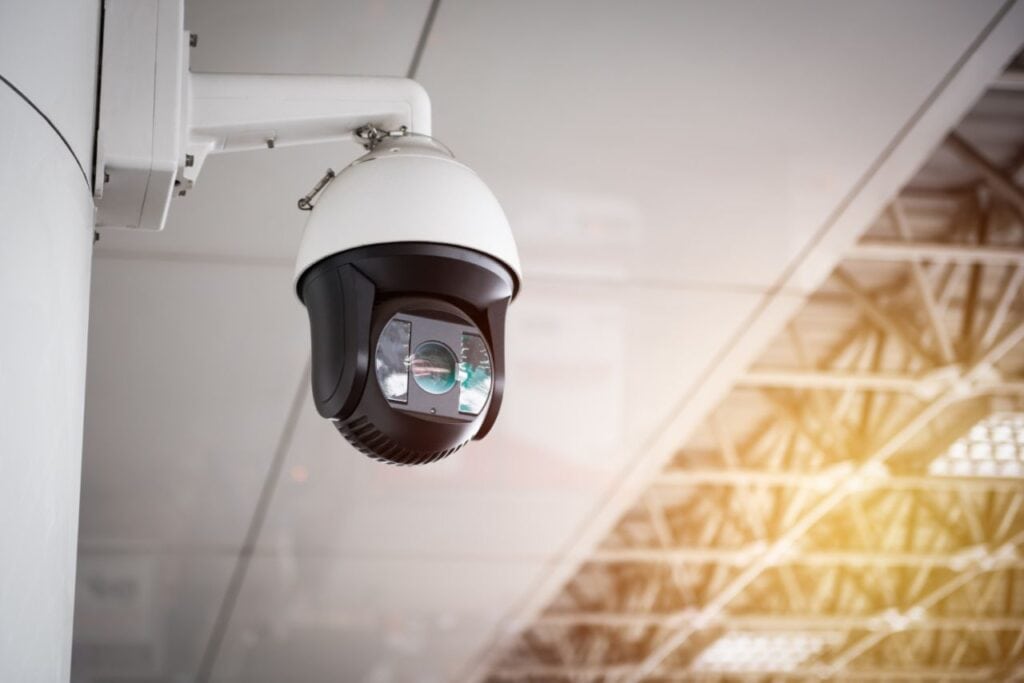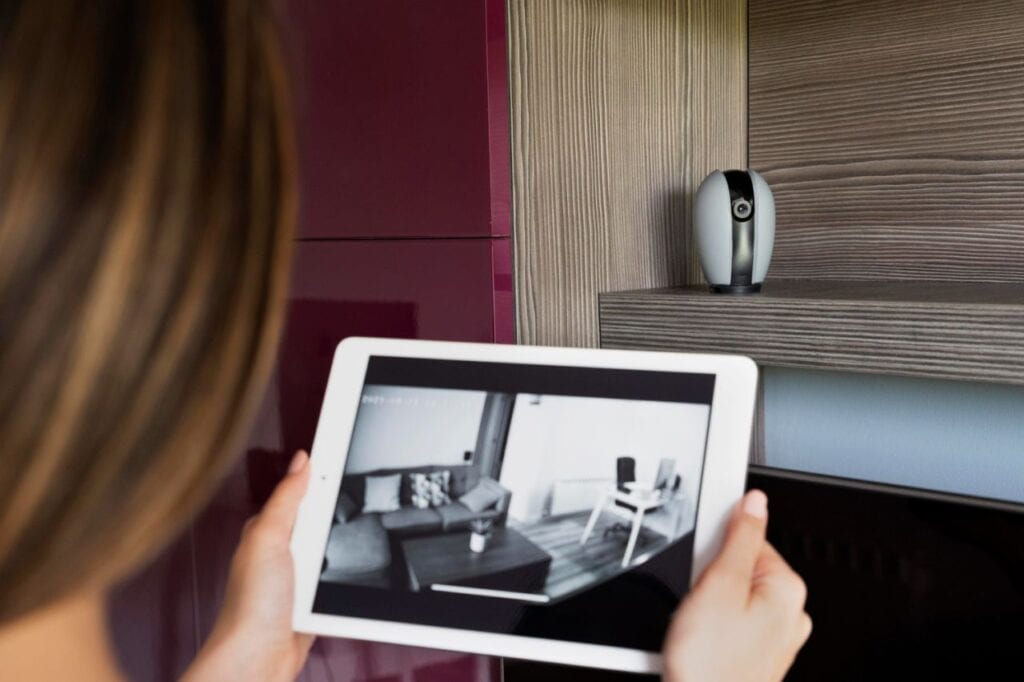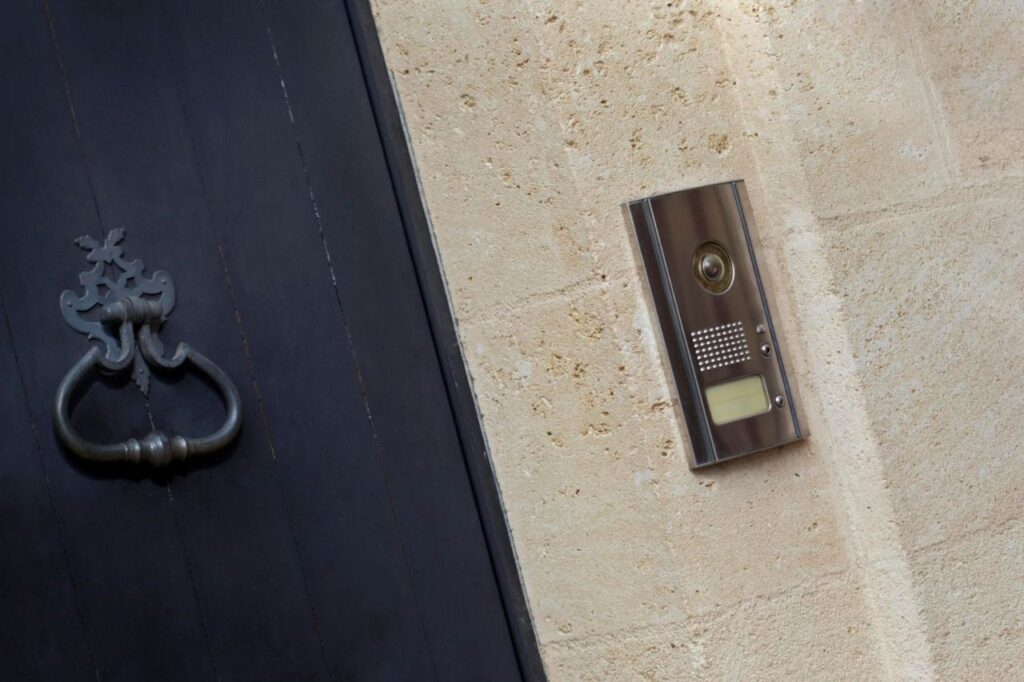An Intercom System Is Defined As
A two-way communication system, or intercom, is an electronics device that allows for simultaneous verbal exchange between multiple users. Guests can gain entrance to a building or property by calling the intercom system and having an occupant remotely unlock a door or gate.
There have been various variations of intercom systems used throughout history. Early intercom systems had users communicating through the tubing, which acted like a string connecting two cans to transmit their voices to one another. But newer electronic intercoms have circuitry for digitally transmitting and receiving sound and video.
Even though intercoms have a wide variety of potential uses, they were originally designed to facilitate two-way communication and secure access to private property.
An intercom, often known as a talkback or door phone, is a standalone voice communications system used mostly within a single building or a small cluster of buildings. It's a two-way electrical gadget with circuitry for receiving and sending audio and/or video signals.
Through the use of an intercom system, a person in one room can be heard by those in another through the use of a speaker and microphone.
It's no longer accurate to think of intercom systems in terms of the archaic door buzzer panel, which often only had a single line and button. Intercom systems are quickly becoming the de facto standard for integrating voice and video in a variety of business and institutional settings.
There is a wide selection of intercom designs available. Some of them are relatively simple to operate, whereas others can be a real pain. There are a variety of intercom systems available, including audio, video, integratable, and multi-tenant.
You can find a wide selection of intercoms, each with its own unique look and feel. There are both simple and complex patterns available. Putting aside the aesthetic differences, there are intercoms that serve only certain purposes.
Intercom System Components
The two main parts of today's intercom systems are:
- One of these base stations.
- The use of a substation or substations.
The central part of an intercom is the base station, also known as the master station. Put in place at the front door, it welcomes visitors and secures the premises.
Two or more substations are linked to the main station. Substations can be located anywhere inside a structure, whether it be a single residence or a large commercial complex.
Base Stations for Intercom Systems

A building's intercom system's base station facilitates two-way communication between the building's exterior and interior.
The base station is the nerve centre of any intercom system, and it is also the point of control for all the other components. The base station should be installed at the property's main entrance and wired to the main electrical supply, the door release mechanism, and each individual substation. The base station and the substations can be connected either via wired or wireless connections.
The visitor base station allows guests to contact any tenant's substation and alert them to their arrival.
If you're looking to buy an intercom system, a good piece of advice is to pick one with a camera already installed in the base station. The added protection and convenience of being able to see who is at the door is a major selling point for this camera system.
Substations
Tenants can speak to visitors even outside the building through intercom system substations. They also feature a "door open" button for residents to use when hosting guests.
In the past, substations were actual physical devices that functioned as a combination of speaker and microphone. You'd have to set them up in strategic locations around the structure and connect them through hardwire to the main hub.
These days, however, people's cellphones serve as the intercom substation, and the hardware at the substation is no longer necessary for an intercom system to function. Tenants may see who's at the entrance through a real-time video call and open the door from anywhere with internet access.
An excellent piece of advice is to set up an intercom network in which cell phones serve as individual nodes. Video calls, remote access to your property, and keyless entry are just some of the extras you may expect. There will be no need to instal separate intercom substations around the facility, saving you money on hardware, wiring, and installation.
Recommendations
- Mount the main intercom station near the building's front door.
- Pick an intercom system that includes a camera that can communicate with its base stations via wireless means.
- Due to the lack of need for additional hardware, smartphones make excellent substations.
How Would an Intercom System Function?
An intercom system allows outsiders to contact occupants of a building and then relay their voices and images to equipment in the building's substations.
The main hub records sound and video and sends it to the outposts. Tenants can screen guests at the substations and have a conversation with them before letting them inside the main building. By pushing a button using their mobile device, tenants can gain access to the building or gate from a safe distance.
How Many Distinct Varieties of Intercoms Are There to Choose From?
There is a great deal of variation in the intercom systems available today. There are wired and wireless options. Some are made specifically for office buildings, while others are made for apartments.
There are typically 9 distinct varieties of intercoms, and they are as follows:
- Wireless intercoms
- Wired intercoms
- Audio intercoms
- Video intercoms
- Outdoor intercoms
- Apartment intercoms
- Commercial intercoms
- Office intercoms
- Gate intercoms
Wireless Intercoms
Wireless systems are utilised in situations where physical wiring would be impractical. Wireless intercom systems are an alternative to hardwired systems when it is impractical or expensive to run cables throughout the facility.
Spectrum, the invisible radio frequencies used by wireless intercoms, carries the signal that allows wireless devices to function. The band utilised in a wireless intercom determines whether or not it can send audio, video, or both. Wireless intercoms and modern wireless networks both transmit voice and video through low-frequency bands (sub-3 GHz).
Inquire about the functionality of the system from the provider if you're thinking about purchasing a wireless intercom. Inspect the strength of nearby wireless and cellphone signals before installing an intercom that uses them.
Electrical interference is just one of several external variables that might disrupt WiFi connections. And a consistent, high-bandwidth access to the mobile network is typically only available through commercial-grade subscriptions. Therefore, an ethernet cable should be used to connect your intercom to the internet.
Wired Intercom Systems
If you want some extra privacy and to avoid interference from other systems, a wired system may be the way to go. In terms of functionality, an intercom system's ability to connect to the internet is the primary differentiator between wired and wireless variants. Wiring is required for all intercoms, albeit the amount varies.
Intercom systems in buildings can save money because they only need to be wired once, at the point of installation. For instance, if you want to instal an intercom and link it to a battery-operated or magnetic door lock, you'll need to run some wires.
Some intercom systems call for extensive wiring throughout the structure. It may be necessary, for instance, to connect each substation to the main hub at the property's entrance via wiring.
An expert recommendation is to use a Cat 5/6 network cable to link your intercom to the internet. This will not only improve the safety of your intercom system but also lessen the possibility of disruption from other wireless and electrical signals.
Audio-Only Intercom
In a building, a visitor can use an audio intercom, sometimes known as a buzzer, to communicate with occupants. A door release mechanism integrated into an audio intercom system would allow the tenant to let the guest into the building. Video intercoms have become the norm in modern construction, making audio intercoms a rarity save in historic homes.
If you're developing and constructing a brand-new building, take this piece of advice: ditch the buzzer and use a video intercom instead. They cost about the same as regular audio intercoms but have more useful features. In addition, a visual intercom is a viable replacement for an audio intercom. However, before you instal the intercom, make sure that the area has adequate wiring.
With-Video Intercoms
A typical setup would consist of an external monitoring unit (with a camera, audio, and button leading to the door) and an interior monitoring unit (with the ability to talk to the external unit). Some intercoms can even send video in addition to sound.
A video intercom call necessitates:
- An instrument for recording moving images
- It needs to be displayed on a screen.
The best video intercoms have a built-in camera; however an external camera will also do. The video footage will be displayed on specialised gear that you will set up at strategic points around the building. A video intercom should ideally be hardwired into the internet, as video uses far more data than audio.
Here's a pro tip: think about getting a video intercom that can forward calls to mobile phones while you're shopping for one for your building. Tenants may check in on who's knocking at their door and let them in from any location. You also save money by avoiding the costs of buying and installing gear within the unit.
Intercoms That Can Be Used Outside of Buildings
Many buildings, especially those with gates, need an external intercom that can survive all seasons. The components of an outdoor intercom system are designed to withstand the elements. The equipment allows guests to contact the homeowners and ask for entry to the property.
The IP (ingress protection) grade determines how well protected from the elements an outdoor intercom is. Intercoms with an IP65 rating are dust-proof and can withstand water jetted from a nozzle without damage. Select an intercom only with an IP65 score if it will be installed in the great outdoors.
Apartment Intercoms
The visitor selects the appropriate apartment button, the resident responds, and the resident unlocks the door by pressing a button. An apartment intercom is a two-way electronic communication device installed in multi-family buildings to facilitate interaction between tenants and visitors. In addition to communicating with visitors, inhabitants of an apartment building can release the door for them.
The two main components of an apartment intercom system are:
- Apartment intercom systems typically feature a master station in the lobby where guests can look up and call specific residents by name. The main intercom control unit is hardwired to a power source, the door lock, and maybe the internet.
- Apartment complexes often instal intercom substations so that residents may communicate with visitors and let them into their building.
If you want your tenants to use their smartphones as the substation, instal an intercom system that has a mobile app. This allows the resident to view and speak with a visitor from any location, not only the apartment, and to give them access. Furthermore, the equipment, wiring, and labour costs associated with purchasing and building substations in each unit are high.
Office Intercoms
A workplace's intercom system might be either internal or external.
Communicating with others in the building, including coworkers or other employees, is made possible through an internal office intercom system. Like walkie-talkies, they facilitate communication between individuals located in different rooms.
Intercom systems installed outside of the office provide a direct line of communication between employees inside and those outside (like visitors & delivery people). The door release mechanism on external office intercoms is there to facilitate property access.
A helpful hint: smartphones, emails, & messaging apps have mostly supplanted internal workplace intercom systems. It's safe to assume that a commercial intercom is what you want if you're researching "office intercoms." Buildings with multiple tenants must instal commercial intercom systems.
Gate Intercoms
In place of a conventional front door, gates are increasingly used as the primary point of access to many residential and commercial buildings. Vehicles and pedestrians alike can gain entry through an intercom system installed at the gate.
Intercom systems for gates are commonly found in:
- Places that only allow entry from inside a gate
- Commercial Assets
- Entrances to Parking Garages
In the same way that conventional intercom systems necessitate a master terminal and substations, a gate intercom needs both so that those inside the property may communicate with guests who are trying to gain entry and allow them to pass through.
A call button installed on a gate intercom could connect to a substation managed by the building's maintenance crew. Any employee of the property, such as a property manager, a gate guard, a front desk clerk, or anybody else, could fulfil this role.
Because gates are often not adjacent to a structure or building with an available power source, installing an intercom system at the gate might be more of a challenge. That means you might have to run some serious wire to get electricity to it. The gate's price and level of difficulty to set up depending on its position on the property.
Ins and Outs of Intercoms
This is a detailed tutorial on how to operate an intercom system.
- Identify the renter you wish to speak with by using the intercom system installed at the entrance or gate.
- Simply dial the tenant's number or provide their personal code.
- The renter picks up the call on a mobile phone, a landline, or an in-unit device.
- Access can be granted remotely via the tenant's intercom system by simply pressing the "door open" button.
FAQs About Intercoms
Are Intercoms Cheap?
The cost of an intercom system can vary significantly depending on the type and features of the system, as well as the size of the property and the complexity of the installation. In general, wired intercom systems tend to be more expensive than wireless systems due to the cost of installing the physical wires. Handheld intercoms are generally less expensive than multi-unit systems, which are designed for use in larger buildings.
Intercom systems can range in price from a few hundred dollars for a basic doorbell intercom to several thousand dollars for a more advanced multi-unit system. It is important to carefully consider your budget and the specific needs and features of the system before making a purchase. In some cases, it may be worth investing in a more expensive system if it offers enhanced security or convenience features that are important to you.
Is It Safe to Have an Intercom?
Intercom systems can be a useful tool for improving communication and security in a building, as they allow residents or employees to remotely communicate with visitors and grant them access to the building if desired. However, like any security system, intercoms are not completely foolproof and can be vulnerable to certain types of threats.
One potential security risk is that intercoms rely on a microphone and speaker to transmit and receive audio signals. If these devices are not properly secured, it is possible for an unauthorized person to gain access to the audio feed, potentially leading to the theft of personal information or other sensitive data.
Another potential risk is that intercoms can be physically tampered with or damaged. For example, an intruder may try to disable the intercom or break the microphone to prevent it from functioning properly. It is important to regularly inspect and maintain intercom systems to ensure that they are in good working order.
Overall, intercom systems can provide an added level of security and convenience to a building, but it is important to use them in conjunction with other security measures, such as locks and alarms, to maximize protection.
Are Intercoms Common for Establishments?

The prevalence of intercom systems varies depending on the type of establishment and location. Intercom systems are more common in larger buildings, such as apartment buildings and office buildings, where there may be multiple entrances and a need to manage access to the property. They are also often used in gated communities, such as residential developments or condominiums, where security is a top priority.
In smaller buildings or single-family homes, intercom systems may be less common. However, doorbell intercoms, which allow residents to remotely communicate with and grant access to visitors, are becoming increasingly popular for use in single-family homes.
Overall, the use of intercom systems tends to be more common in buildings or properties where security and access control are important considerations.
How Long Will It Take To Instal an Intercom?
The length of time it takes to install an intercom system will depend on the type of system, the size of the property, and the complexity of the installation. In general, it is likely to take longer to install a wired intercom system than a wireless system, as it may be necessary to run physical wires through the building.
For a basic doorbell intercom, the installation process may take a few hours to a full day, depending on the specific system and the complexity of the installation. For a more advanced multi-unit intercom system, the installation process may take several days or even weeks, depending on the size of the building and the number of units.
It is important to carefully review the installation instructions for your specific intercom system and follow them carefully to ensure a smooth and successful installation process. If you are unsure about the installation process or do not feel comfortable completing it yourself, it may be advisable to hire a professional to install the system for you.
Are Intercoms Mandatory?
Intercom systems are not generally considered to be mandatory in most buildings or properties. However, there may be certain situations in which an intercom system is required by law or recommended for safety or security reasons.
For example, in some jurisdictions, intercoms or other security measures may be required in certain types of buildings, such as high-rise apartments or office buildings. These requirements may be imposed by local building codes or other regulations in order to ensure the safety and security of residents or employees.
Additionally, intercom systems may be recommended for certain properties or buildings in order to enhance security or manage access to the property. For example, intercom systems may be recommended for gated communities, buildings with multiple entrances, or properties that have a high risk of break-ins or burglaries.
Overall, whether or not an intercom system is required or recommended for a particular property will depend on the specific circumstances and local regulations. It is important to carefully consider the security and access control needs of your property and consult with a professional if you are unsure about whether an intercom system is necessary.







